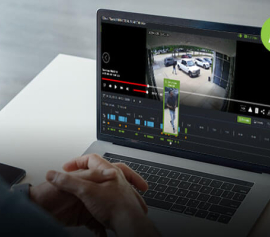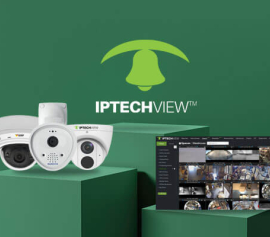What is an RTSP Camera? – Real Time Streaming Protocol Explained

If you deal with surveillance cameras or IP cameras, you likely have heard of RTSP. This technology, which is over twenty years old now, was one of the driving factors of modern technology that utilizes IP cameras, including drones, robots, and security systems.
This article goes into the enduring legacy of RTSP and RTP – protocols that underpin modern IP cameras, even as they incorporate advanced features like HEVC compression and computer vision.
RTSP Camera Explained
RTSP (Real-Time Streaming Protocol) is a control protocol used to manage multimedia streaming sessions. It lets users play, stop, or record content by establishing and organizing media data flow between devices. RTSP guides the server on handling the stream, not moving the media itself.
Then, RTSP cameras—which use the Real-Time Streaming Protocol—are network cameras sending live video and audio across IP networks. Since this technology allows remote monitoring and video stream manipulation, RTSP cameras are thus absolutely essential for surveillance, video conferencing, and live streaming applications.
Originally conceived for entertainment television, RTSP found its early home in the broadcast industry. However, a shift in technological landscape relegated it primarily to the realm of IP cameras.
Understanding RTSP
RTSP functions like a digital remote control for media servers. It enables users to start, pause, or stop video streams over the internet. Unlike traditional infrared remotes, RTSP doesn't transmit the video content itself but instead commands the media server to manage the stream.
RTP—Real-Time Protocol—is the orchestra; RTSP is the conductor. RTP is what really provides the audio and video data in real-time, even as RTSP plans the streaming session and tells the media server when to play, pause, or stop. Most IP camera systems center this dynamic team on their backbone.
Although both TCP and UDP can theoretically be used for RTP, given their minimal overhead and real-time performance needs, UDP is the recommended choice.
Key Features of RTSP Cameras
RTSP makes security cameras versatile. It lets cameras talk to different recording devices, like computers or network storage. This means you can save videos in multiple places for backup or legal reasons.
Here are the key features of RTSP cameras:
- Real-Time Streaming: RTSP cameras excel at delivering live video with minimal delay, making them ideal for applications demanding real-time monitoring and surveillance.
- Compatibility: RTSP cameras offer broad compatibility, working seamlessly with a variety of RTSP-enabled devices and software. This flexibility allows users to access video feeds from computers, smartphones, and other networked platforms without relying on proprietary systems.
- Control Commands: RTSP commands offer granular control over streaming sessions. Users can seamlessly adjust playback, like play, pause, and seek, as well as manage other aspects of the media stream.
- Integration with Other Protocols: Many RTSP cameras also support the ONVIF standard, significantly expanding their compatibility with a wide range of security systems and devices. This versatility ensures seamless integration into different environments.
Uses of RTSP Cameras
Yes, RTSP cameras are mainly used for surveillance of homes and organizations as well as broadcasting live events. But when should you decide to use cameras equipped with this type of technology? Here are the possible answers:
1. ONVIF-Compliant RTSP Stream
RTSP is primarily used in security cameras as a complementary protocol to ONVIF. While ONVIF establishes a standardized communication framework for IP video devices, RTSP focuses on real-time media streaming.
When integrating a third-party IP camera with a recording system, ONVIF compatibility is often the preferred method. However, if ONVIF fails to establish a connection, RTSP can serve as an alternative. Many professional NVR or XVR systems offer flexible camera integration options, including the ability to access a camera's RTSP stream directly. This provides an additional method for incorporating non-compliant or challenging cameras into the surveillance system.
2. Recording or Live Back Up
RTSP streaming offers versatile capabilities, including the ability to re-record and store the stream on a separate server or recorder. As a well-established protocol, RTSP enjoys widespread support from numerous media and NAS servers.
Notably, most XVR and NVR systems not only output RTSP streams for video distribution but can also ingest incoming RTSP streams for recording. This dual functionality proves invaluable for customers seeking secondary or redundant video backups, as well as for industries with stringent regulatory compliance requirements, such as the marijuana sector.
3. Smart Home System
Smart home integrators leverage RTSP compatibility to seamlessly integrate security cameras and recorders into home automation systems. This technology enables simultaneous video streaming to multiple devices, such as tablets and home control stations, offering users convenient access to live footage from anywhere within their home or business.
4. Live Streaming Services
Broadcasting security camera footage to live streaming platforms is another popular application of RTSP. Common use cases include live feeds from animal sanctuaries, national parks, zoos, beaches, and construction sites.
While most live streaming platforms prefer RTMP (Real-Time Messaging Protocol), RTSP streams can be seamlessly integrated using streaming software like the open-source OBS (Open Broadcaster Software).
Commercial alternatives such as XSplit, VMIX, and Wirecast offer additional features and capabilities. Once configured, these tools can convert RTSP to RTMP, enabling live broadcasts on platforms like YouTube, Facebook Live, or Twitch.
What is the Best Camera for RTSP?
Selecting the optimal RTSP camera hinges on your specific requirements and budget. Key factors to consider when making your choice include:
- Resolution
- Frame rate
- Night vision
- Weather resistance
- Brand and support
Check out IPTECHVIEW’s smart cameras that support RTSP for the most secure video surveillance.






